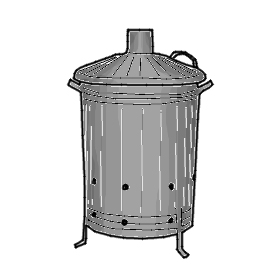Resumen ejecutivo
Small-scale incinerators are a useful technology to combust household waste, medical waste, slaughter waste, etc. instead of discharging it in a landfill. Furthermore, heat and energy may be recovered and it helps to avoid open burning of municipal waste which creates much more harmful emissions and endanger human health and environment. Costs for these incinerators range from very high to low, but it is often possible to construct the incinerators by instructed community members and with local materials such as bricks and steel. The waste should be separated previously in order to retain organics or recyclable material before incineration. The ashes can contain toxic substances and heavy metals and should therefore, if possible, be disposed of safely. Trained labourers should operate such systems and always wear gloves and face masks to avoid injuries and health risks.
| Entradas | Salidas |
|---|---|
Energy |
Introduction
For many countries, modern large-scale incineration plants are not available because of a lack of know-how and financial resources. Also, properly managed landfills are not always available to dispose solid waste. Open dumps and poorly designed and managed landfills lead to (ground-)water pollution (landfill leachate) and contamination of surface water sources.
Small-scale incinerators can reduce the volume of non-recyclable wastes (e.g. household waste, medical waste, slaughter waste). Moreover, heat and energy may be recovered and it helps to avoid open burning of municipal waste, which creates much more harmful emissions and endangers human health and environment.
Open waste burning
Urban air pollution due to open incineration of municipal waste or incineration in systems without or with only poorly designed flue gas cleaning systems results in a serious health risk. Another big problem is uncontrolled landfill fires and open burning on the streets. Uncontrolled burning of waste is largely obsolete in developed countries, but continues to be practised in developing regions, causing the release of CO2 and other greenhouse gases. Some landfills in developing countries, such as the Smokey Mountain site in Manila, smoulder continuously (UNEP 2010). Another big problem is the “recycling” of e-waste in developing countries. This waste contains toxic chemicals such as lead or mercury. It is often burned to remove plastic and reclaim the valuable metals (GREENPEACE 2008).
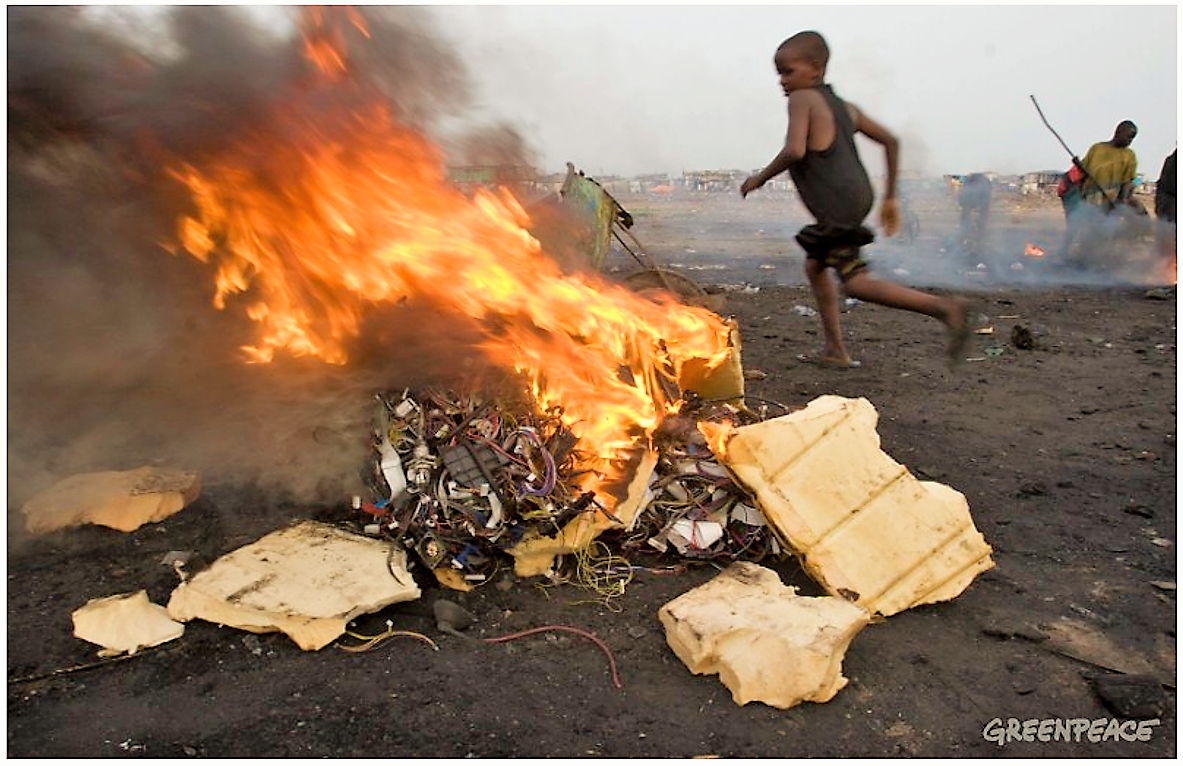
Open waste dumping
Open waste dumps are often located close to residential areas and cities. Igniting them or burning waste piles accounts for a higher share in the dioxin inventory than all industrial sources together. It also results in substantial contamination of the environment and in high exposures of people to dangerous toxins, as people in such areas are directly exposed to the plumes from fires and children often play around the burning sites (UNEP 2009).
Basic design principles
Modular incinerator
Modular incinerators are normally prefabricated units with relatively small capacities of between 5 and 120 tons of solid waste per day. Read more about them in large scale incineration systems.
Pre-fabricated products
There are several pre-fabricated small-scale incinerators (12–100 kg/hour) for all kinds of waste (medical waste, waste oil, animal by-products, etc.) and locations (farms, mines, truck stops, construction sites, etc.). A collection of the products that are currently commercial available can be found in PATH (2010).
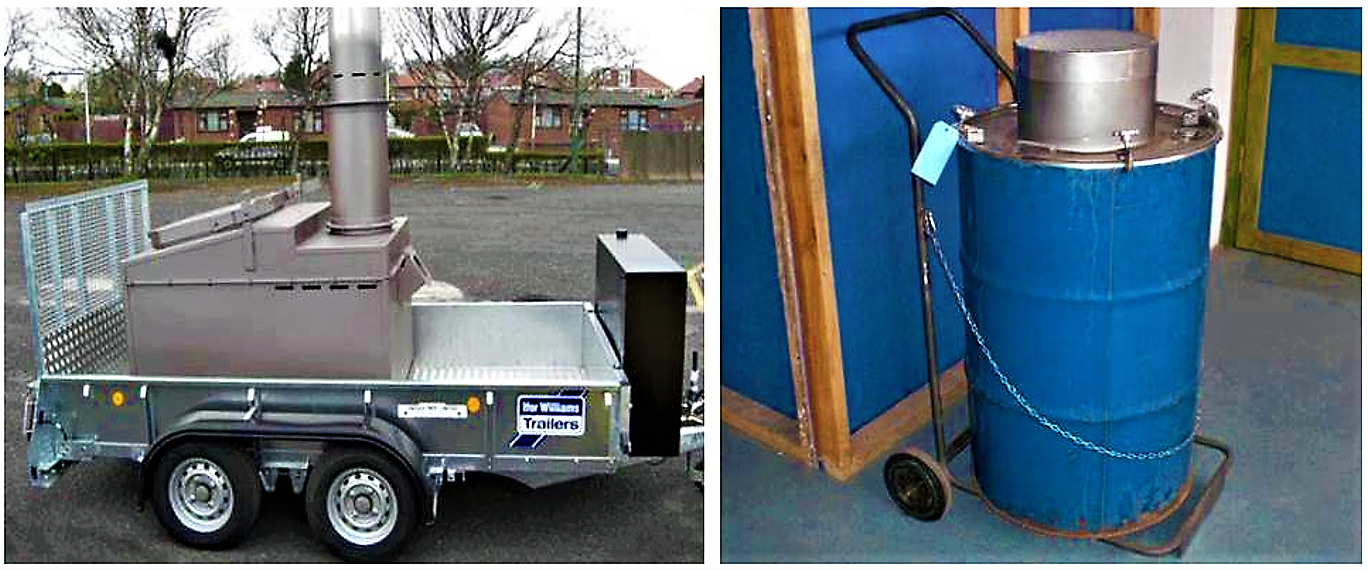
Medical waset incinerator
(Adapted from PRACTICAL ACTION 2000)
The medical waste incinerator, which could be built in almost every developing country, is a simple two-chamber natural-draught incinerator designed to be operated at temperatures of 800°C and higher. The performance of the incinerator varies depending on the moisture content of the medical waste but a throughput of up to 15 kg/hour can be achieved. The incinerator has been designed so that it can be built on site, using standard building bricks or blocks and lined with refractory bricks. All the steel components, such as the loading door, the ash removal door and air inlet apertures can be made using basic workshop equipment. The two-chamber design helps to ensure that the combustion time is sufficient to destroy the products of combustion and minimise any harmful emissions.
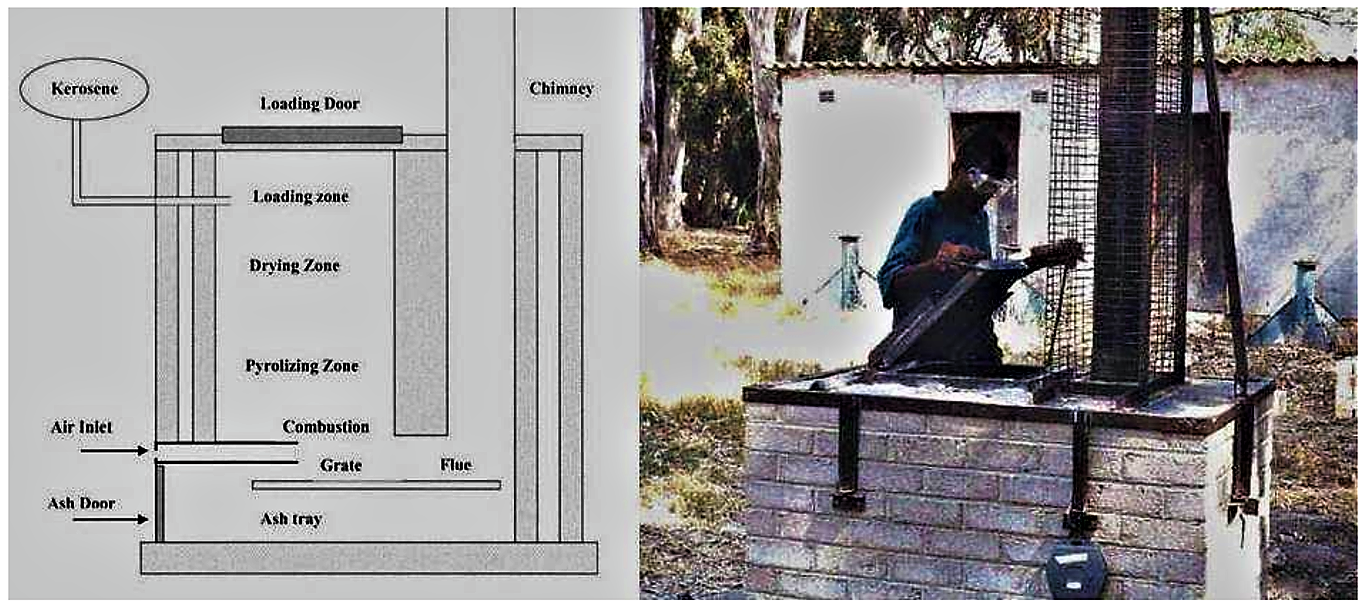
Cost considerations
The costs for small incinerators depend on the technology of the incinerator. If the incinerator is constructed locally (e.g. the medical incinerator which is described above), costs are much lower than for a fancy pre-fabricated product. Beside capital costs, costs for operation and maintenance as well as fuel (dry wood, charcoal, fuel oil, waste vegetable oil, etc.) must be budgeted (PATH 2010).
It is important to choose the appropriate incinerator to guarantee a long lifetime and minimise costs. The following are key steps to follow when selecting the appropriate incinerator for HCW Management to meet country and programmatic needs (PATH 2010):
-
Determine your health system needs for HCWM treatment and disposal solutions.
-
Assess the infrastructure of the area.
-
Identify locally available incinerator designs and exchange with other people from the region who have experience with small-scale incinerators.
-
Determine the availability of local resources to support construction and operation.
-
Assess the policy environment.
-
Develop cost estimates.
-
Choose designs and determine which units to procure.
Health Aspects
As described above, open burning or dumping of waste creates many health hazards due to toxic smoke, poor hygienic conditions, and leaching of toxic substances into the groundwater and soil. The residents who live very close to open burning sites are directly exposed to the plumes of the fires. Poorly designed incinerators (e.g. if the temperature is too low or there is a malfunction of the flue gas cleaning system) often result in the release of high levels of particulates, acid gases, heavy metal vapours, carbon monoxide, dioxins, and other toxins, some of which are carcinogenic. These pollutants can cause very serious human health problems. One of the most harmful pollutants released during backyard burning of trash is dioxin. Dioxin is a known carcinogen and is associated with birth defects. Dioxin can be inhaled directly or deposited on soil, water and crops where it becomes part of the food chain (DES 2011).
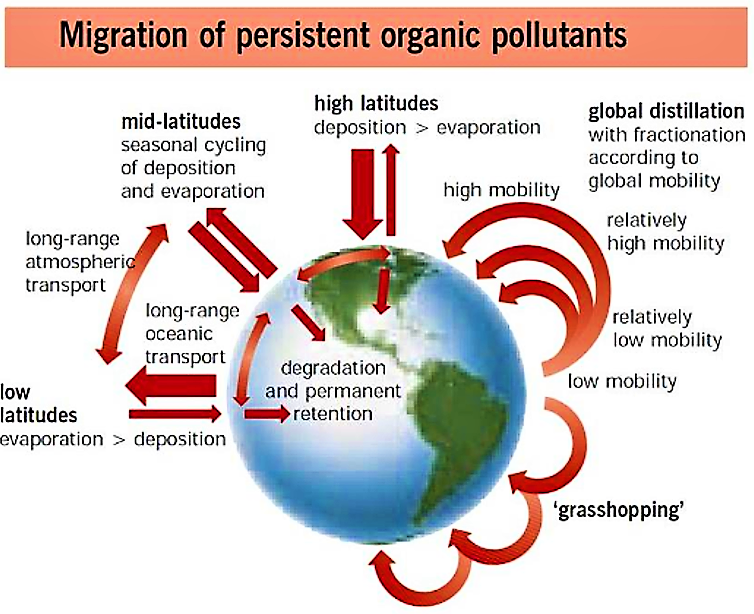
Operation and Maintenance
Regardless of the type of incinerator that is in use, the operator must be trained to avoid accidents, damages, injuries, and to minimise health risks. Furthermore, the operator must wear heat-resistant gloves and boots, a respirator mask, safety goggles, clothes that cover the body, and a helmet. Proper operation of an incinerator ensures safe and optimal performance (e.g. temperature, loading rate, etc.) (PATH 2010). Regular inspection is necessary to prolong the lifetime and avoid damages.
Safety notes for the operator of small-scale incinerators (PRACTICAL ACTION 2000):
-
Opening the loading door may cause blowback to occur and the flame to flare up out of the loading door.
-
Particular care should be taken when using kerosene, as atomised vaporised fuel may be present at the top of the combustion chamber, which could ignite vigorously.
-
If the loading door is designed so that it hinges from the front of the incinerator and opens towards the operator, the operator should open the door while standing at the front of the incinerator. This provides the operator with some protection from any blowback and keeps him/her away from the opening to the combustion chamber.
-
The operator should wait a few moments to allow any blow back to die down before loading waste materials into the incinerator.
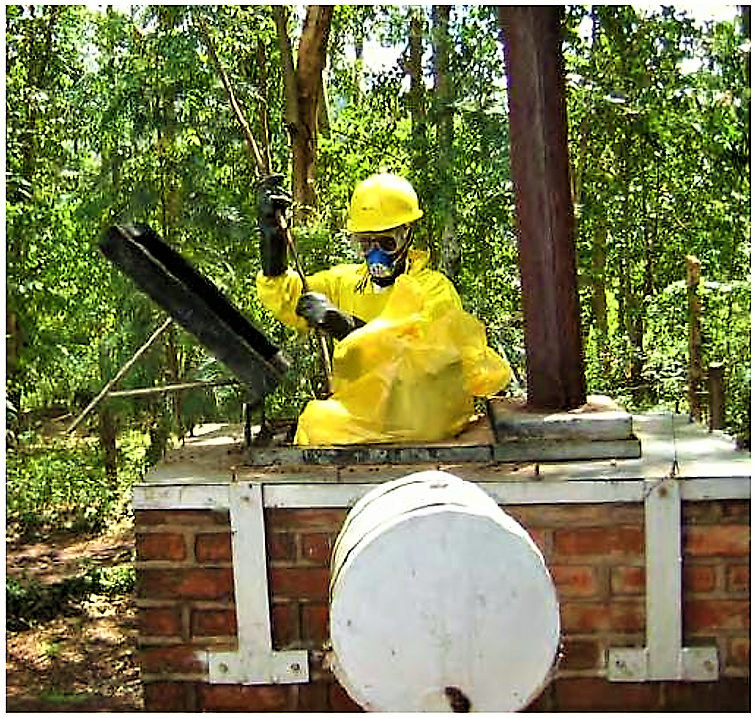
At a glance
| Working principle | Small scale incinerators are used for all kinds of waste incineration. Some of them are pre-fabricated or constructed by local communities and locally available material (bricks, steel). It is important that the incinerators reach a high temperature to fully combust the waste. Open burning should be avoided. |
| Capacity/adequacy | It is a common practice in many countries and there are also low-cost incinerators. |
| Performance | High if correctly constructed and operated. |
| Costs | Beside high-tech combustors, there also low-cost incinerators. |
| Self-help compatibility | Very high if they are constructed by the community. |
| O&M | Needs trained operators. |
| Reliability | Mostly reliable, but there is a risk of malfunction if not properly maintained and operated. |
| Main strength | No landfills, disinfection of medical waste. |
| Main weakness | Leads to air pollution. |
In many countries, open burning of waste is still practiced if there is no other possibility to discharge the waste. Better solutions than open burning or landfilling are small-scale incinerators. These systems can be adapted to their use (e.g. medical waste, slaughtering waste) and provide a clean combustion without too many harmful emissions. Low-cost incinerators could be a possible solution to discharge harmful waste from poor communities.
Poisoning the poor – Electronic Waste in Ghana
The latest place where we have discovered high tech toxic trash causing horrendous pollution is in Ghana. Our analysis of samples taken from two electronic waste (e-waste) scrap yards in Ghana has revealed severe contamination with hazardous chemicals.
GREENPEACE (2008): Poisoning the poor – Electronic Waste in Ghana. Amsterdam: Greenpeace International URL [Visita: 03.10.2012]Open Burning of Residential Trash
“Open burning” means the burning of any type of combustible material in the open, where smoke and other emissions are released directly to the air. During open burning, air pollutants do not pass through a stack, chimney, or flue. Read more in this factsheet about the definition and what can be done by homeowners instead of burning.
DES (2011): Open Burning of Residential Trash. Environmental Fact Sheet. Concord: New Hampshire Department of Environmental Services URL [Visita: 03.10.2012]Waste Incineration – Mobile Incinerators
Mobile Mini Incinerator
The Incinerator Guidebook
This guidebook is intended to be a practical guide for selecting, purchasing, installing, operating, and maintaining small-scale incinerators in low-resource settings. Small-scale refers to incinerators with a capacity to destroy approximately 12 to 100 kilograms of waste per hour. For the duration of this document, the term incinerator will refer to small-scale incinerators. This guide was designed to help program planners address the challenges of safe management of health care waste (HCW). Every country and health setting faces different challenges to managing HCW safely. There is no one solution or technology that meets all needs. Programs must spend time to effectively plan and introduce any treatment solutions. The following information has been gathered to assist with this process.
PATH (2010): The Incinerator Guidebook. A Practical Guide for Selecting, Purchasing, Installing, Operating and Maintaining Small-Scale Incinerators in Low-Resource Settings. Seattle: PATH URL [Visita: 19.03.2012]Low-Cost Medical Waste Incinerator
A guide to build, operate and maintain a low-cost medical waste incinerator.
PRACTICAL ACTION (2000): Low-Cost Medical Waste Incinerator. Rugby: Practical Action URL [Visita: 10.06.2019]State of the Environment and Policy Retrospective: 1972–2002
Over the past three decades, anthropogenic emissions of chemical compounds into the atmosphere have caused many environmental and health problems. Some chemicals, such as chlorofluorocarbons (CFCs), are produced deliberately and end up in the atmosphere by accident from equipment or goods. Others, such as sulphur dioxide (SO2) and carbon monoxide (CO), are unavoidable by-products of burning fossil fuels. Urban air pollution, acid rain, contamination by toxic chemicals (some of them persistent and transported over long distances), depletion of the stratospheric ozone layer and changes in the global climatic system are all important environmental threats to ecosystems and human wellbeing.
UNEP (2002): State of the Environment and Policy Retrospective: 1972–2002. Chapter 2-7: Atmosphere. London: Earthscan Publications Ltd URL [Visita: 10.06.2019]Hazardous Substances from Open Burning Waste in Developing Countries
The overall goal of the project is to develop a methodology for determining emission factors for unintentional POPs generated in open waste burning processes. The second objective is to develop scientifically sound emission factors for open burning of waste with active participation of developing countries and under their national and local conditions. The project will provide validated emission factors for Toolkit and an enhanced methodology for the determination of the national activity. The final users will be Parties to the Stockholm Convention in their national reporting.
UNEP (2009): Hazardous Substances from Open Burning Waste in Developing Countries. Osaka/Shiga: United Nations Environmental Programme (UNEP). [Accessed: 19.03.2012] PDFWaste and Climate Change
This report is intended as a further step in a global dialogue to engage the international waste community, identify the key issues, and create a strategy that will deliver significant climate benefit in the waste sector.
UNEP (2010): Waste and Climate Change. Osaka/Shiga: United Nations Environment Programme (UNEP) URL [Visita: 19.03.2012]Open Burning of Residential Trash
“Open burning” means the burning of any type of combustible material in the open, where smoke and other emissions are released directly to the air. During open burning, air pollutants do not pass through a stack, chimney, or flue. Read more in this factsheet about the definition and what can be done by homeowners instead of burning.
DES (2011): Open Burning of Residential Trash. Environmental Fact Sheet. Concord: New Hampshire Department of Environmental Services URL [Visita: 03.10.2012]The Incinerator Guidebook
This guidebook is intended to be a practical guide for selecting, purchasing, installing, operating, and maintaining small-scale incinerators in low-resource settings. Small-scale refers to incinerators with a capacity to destroy approximately 12 to 100 kilograms of waste per hour. For the duration of this document, the term incinerator will refer to small-scale incinerators. This guide was designed to help program planners address the challenges of safe management of health care waste (HCW). Every country and health setting faces different challenges to managing HCW safely. There is no one solution or technology that meets all needs. Programs must spend time to effectively plan and introduce any treatment solutions. The following information has been gathered to assist with this process.
PATH (2010): The Incinerator Guidebook. A Practical Guide for Selecting, Purchasing, Installing, Operating and Maintaining Small-Scale Incinerators in Low-Resource Settings. Seattle: PATH URL [Visita: 19.03.2012]Low-Cost Medical Waste Incinerator
A guide to build, operate and maintain a low-cost medical waste incinerator.
PRACTICAL ACTION (2000): Low-Cost Medical Waste Incinerator. Rugby: Practical Action URL [Visita: 10.06.2019]Practical Tools on Small-scale Incinerators for Biomedical Waste Management
This guideline provides practical information on the siting and construction of small-scale incinerators for biomedical waste treatment in Imidugudu, small towns and cities.
REMA (2010): Practical Tools on Small-scale Incinerators for Biomedical Waste Management. Kigali City: Rwanda Environment Management Authority (REMA) URL [Visita: 19.03.2012]State of the Environment and Policy Retrospective: 1972–2002
Over the past three decades, anthropogenic emissions of chemical compounds into the atmosphere have caused many environmental and health problems. Some chemicals, such as chlorofluorocarbons (CFCs), are produced deliberately and end up in the atmosphere by accident from equipment or goods. Others, such as sulphur dioxide (SO2) and carbon monoxide (CO), are unavoidable by-products of burning fossil fuels. Urban air pollution, acid rain, contamination by toxic chemicals (some of them persistent and transported over long distances), depletion of the stratospheric ozone layer and changes in the global climatic system are all important environmental threats to ecosystems and human wellbeing.
UNEP (2002): State of the Environment and Policy Retrospective: 1972–2002. Chapter 2-7: Atmosphere. London: Earthscan Publications Ltd URL [Visita: 10.06.2019]Hazardous Substances from Open Burning Waste in Developing Countries
The overall goal of the project is to develop a methodology for determining emission factors for unintentional POPs generated in open waste burning processes. The second objective is to develop scientifically sound emission factors for open burning of waste with active participation of developing countries and under their national and local conditions. The project will provide validated emission factors for Toolkit and an enhanced methodology for the determination of the national activity. The final users will be Parties to the Stockholm Convention in their national reporting.
UNEP (2009): Hazardous Substances from Open Burning Waste in Developing Countries. Osaka/Shiga: United Nations Environmental Programme (UNEP). [Accessed: 19.03.2012] PDFWaste and Climate Change
This report is intended as a further step in a global dialogue to engage the international waste community, identify the key issues, and create a strategy that will deliver significant climate benefit in the waste sector.
UNEP (2010): Waste and Climate Change. Osaka/Shiga: United Nations Environment Programme (UNEP) URL [Visita: 19.03.2012]Guidelines for the Utilisation and Disposal of Wastewater Sludge
Traditional practices related to wastewater sludge management include dedicated land disposal, waste piling, landfill disposal and, to a lesser degree, use in agricultural practices. However, due to varying reasons, on-site land disposal and waste piling have become the standard management options for many wastewater treatment plants in South Africa today. With sludge production increasing on a daily basis, it has however become apparent that current practices are unsustainable with sludge management becoming a problem for many municipalities in South Africa. Innovative solutions need to be sought to create opportunities that provide a wide spectrum of options to the management of wastewater sludge. This guideline aims to provide options and opportunities for this innovation and to encourage the beneficial use of wastewater sludge. Where wastewater sludge cannot be used as a resource, the guidelines also provide for its disposal in a responsible manner.
HERSELMAN, J. E. BURGER, L. W. MOODLEY, P. (2008): Guidelines for the Utilisation and Disposal of Wastewater Sludge. Volume 5: Requirements for thermal sludge management practices and for commercial products containing sludge. Pretoria: Water Research Commission (WRC) URL [Visita: 19.03.2012]Sludge Treatment and Disposal
Sludge Treatment and Disposal is the sixth volume in the series Biological Wastewater Treatment. The book covers in a clear and informative way the sludge characteristics, production, treatment (thickening, dewatering, stabilisation, pathogens removal) and disposal (land application for agricultural purposes, sanitary landfills, landfarming and other methods). Environmental and public health issues are also fully described.
ANDREOLI, C.V. ; SPERLING, M. von ; FERNANDES, F. (2007): Sludge Treatment and Disposal. (= Biological Wastewater Treatment Series , 6 ). London: International Water Association (IWA) Publishing URL [Visita: 27.05.2019]Selected POPs Waste “Hot Spots” around the World
Some of the POPs are pesticides; others are industrial chemicals; and some occur as unintentional by-products of chemical and combustion processes. Learn more about the “hot spots” in this paper.
IPEN (2009): Selected POPs Waste “Hot Spots” around the World. Prague: Arnika Association URL [Visita: 15.03.2012]A Study on Waste Incineration Activities in Nairobi that Release Dioxin and Furan into the Environment
This report outlines the findings of a study carried out in and around the city of Nairobi, Kenya by ENVILEAD. The study was carried out between the months of January and March 2005, about the patterns of practice that are likely to release persistent organic pollutants (POPs) into the environment as part of the International POPs Elimination Project (IPEP’s) initiatives. The focus of the study was the practice of medical and municipal waste burning, which research has shown to be a potential source of unintentional POPs (UPOPs). The study’s objective was to investigate the anatomy of this practice, identify the key issues involved and make recommendations for the way forward.
ENVILEAD (2005): A Study on Waste Incineration Activities in Nairobi that Release Dioxin and Furan into the Environment. Nairobi: Environmental Liaison, Education and Action for Development (ENVILEAD) URL [Visita: 10.06.2019]Incinerators Trash Community Health
The incinerator industry often promotes incinerators as having “zero emissions” or as being “safe for community health”. The truth, however, is that all incinerators contaminate people and the environment with toxic and cancer-causing emissions.
GAIA (2008): Incinerators Trash Community Health. Quezon City: Global Alliance for Incinerator Alternatives (GAIA) URL [Visita: 10.06.2019]Poisoning the poor – Electronic Waste in Ghana
The latest place where we have discovered high tech toxic trash causing horrendous pollution is in Ghana. Our analysis of samples taken from two electronic waste (e-waste) scrap yards in Ghana has revealed severe contamination with hazardous chemicals.
Welcome to the new "De Montfort" medical waste incinerators website !
This is a website about the new “de Montfort” medical waste incinerator and includes a description about construction, models, O&M and field experiences.

